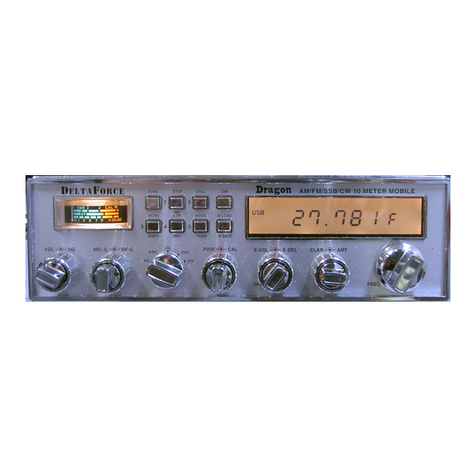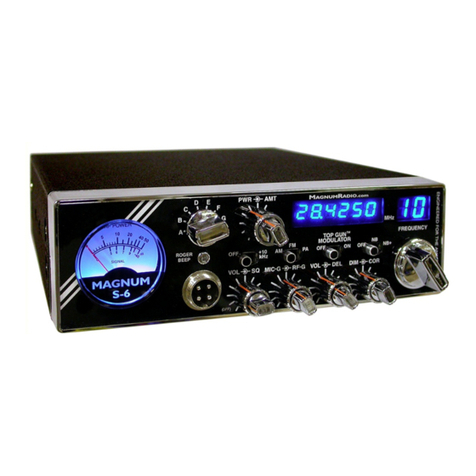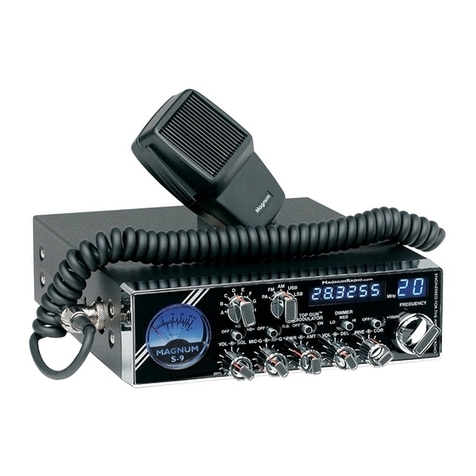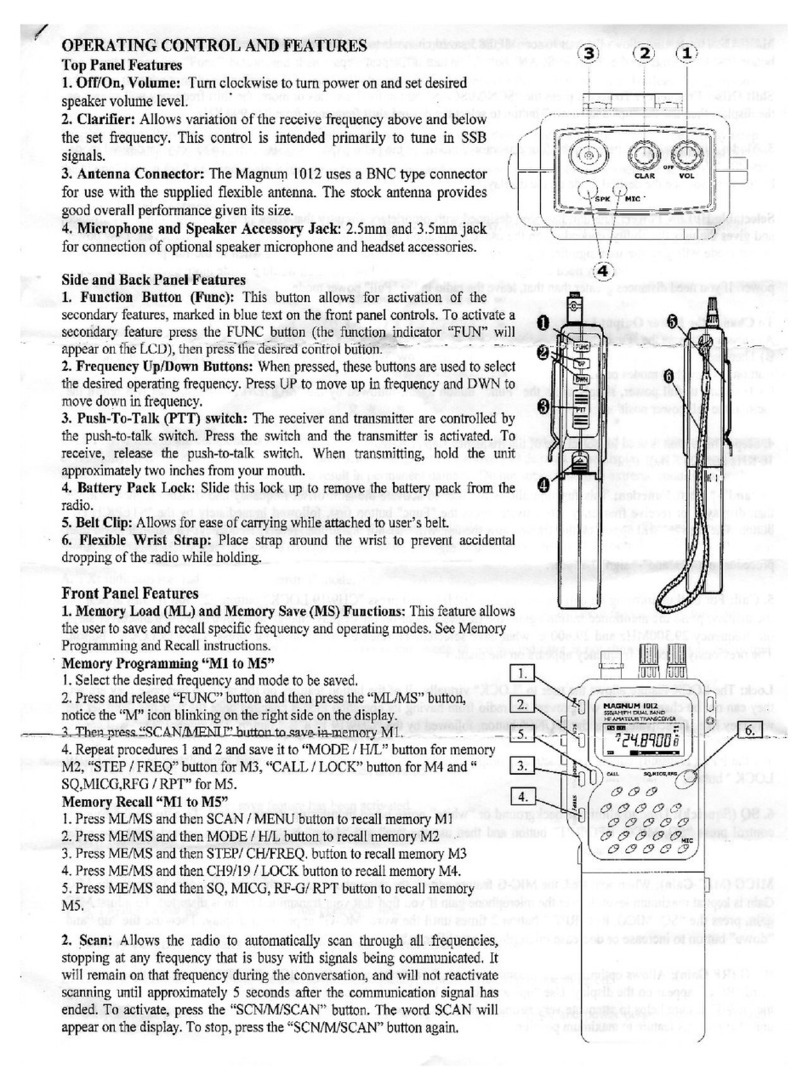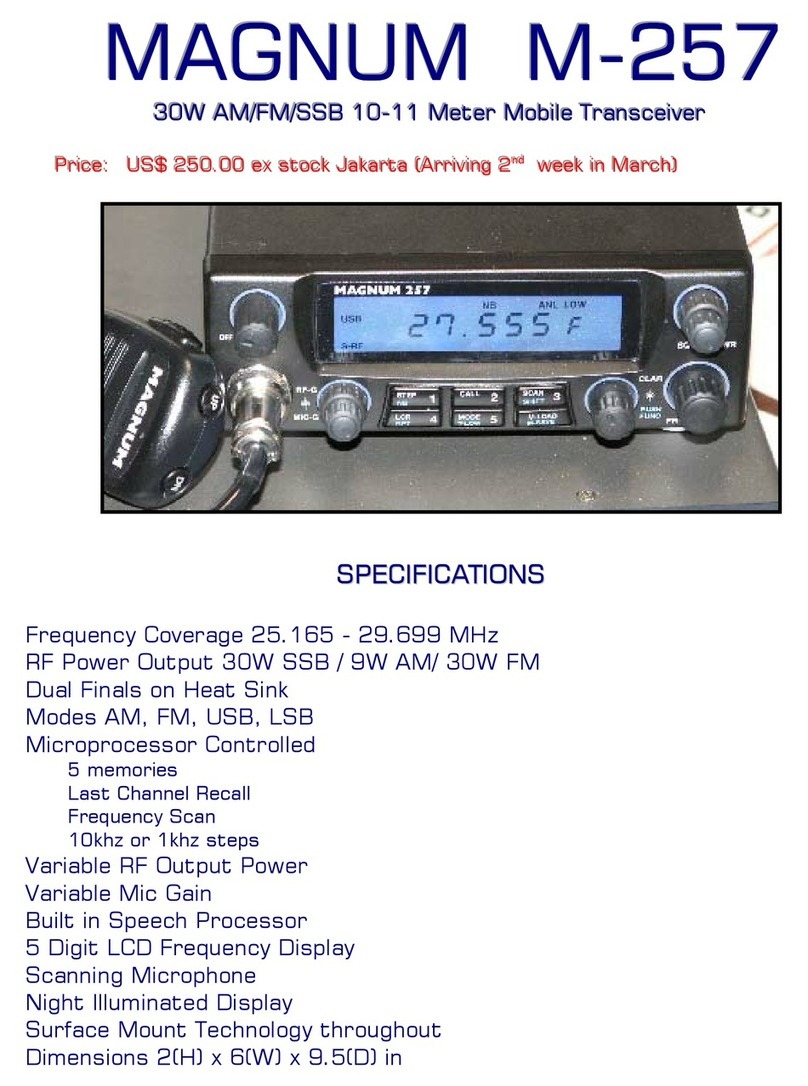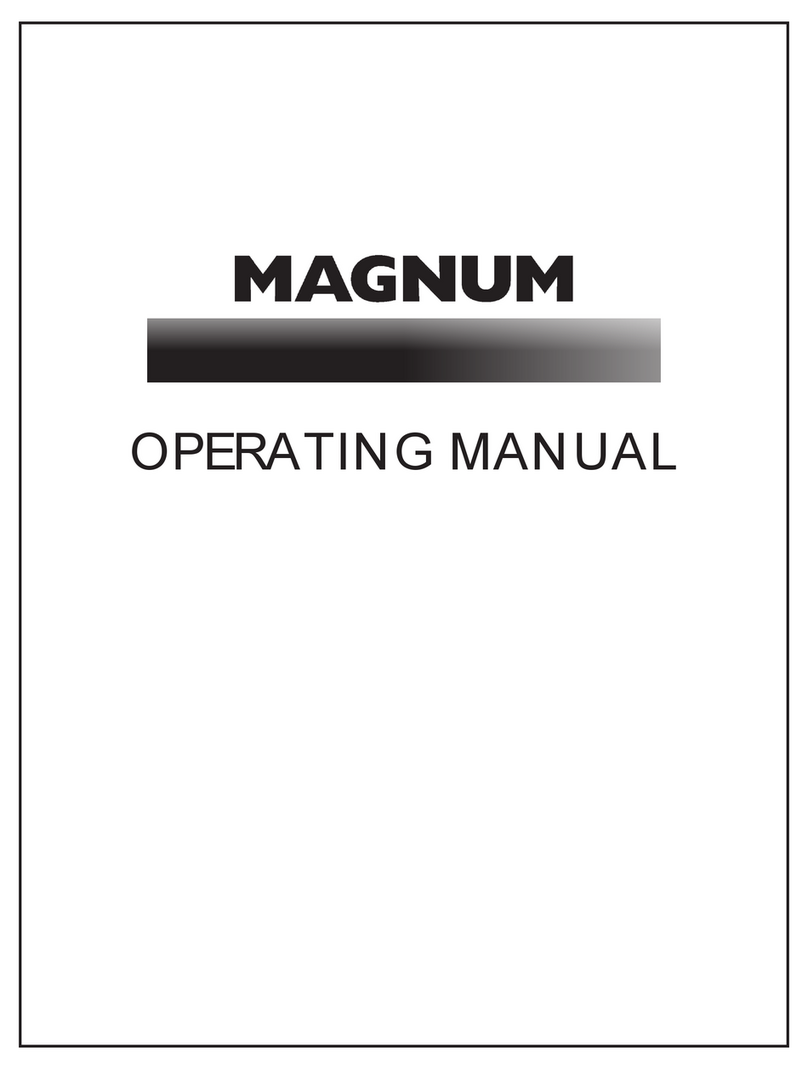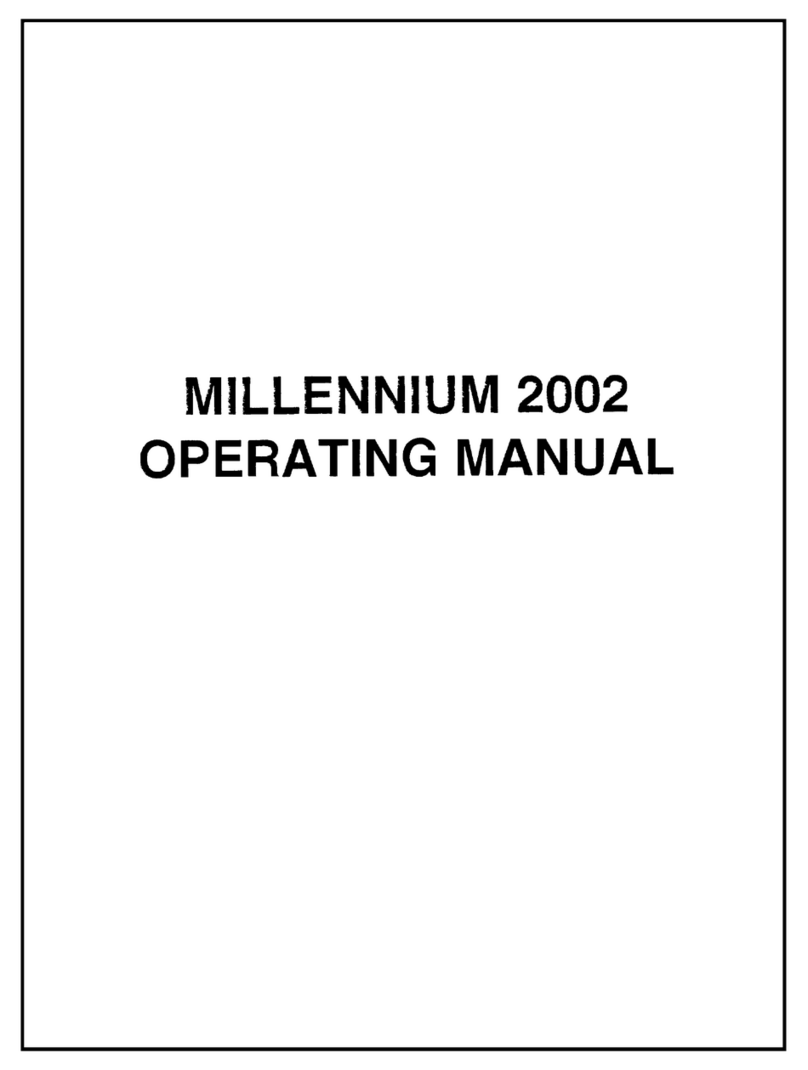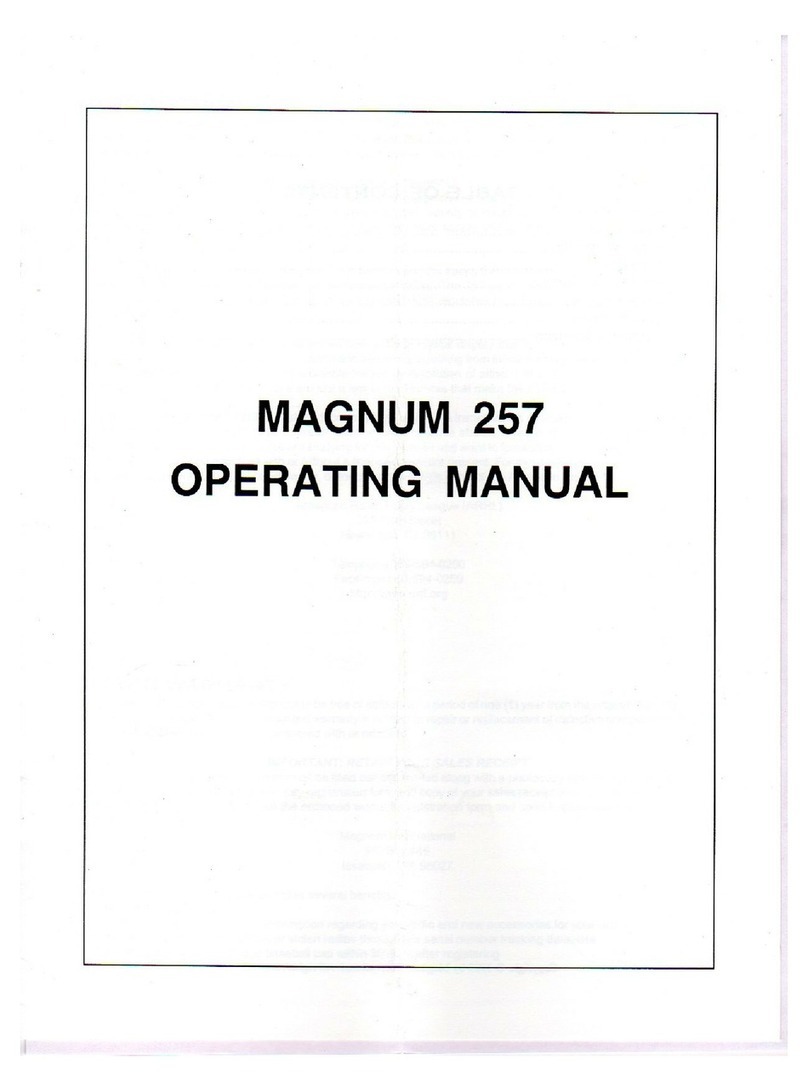
- 9 -
RPT: Repeater Access Tone. Most repeaters require
an 88.5 Hz tone burst to access. To activate the 88.5
Hz tone burst, press the FUNC control and then press
theRPTbutton. RPT will appearon the LCD indicating
that the tone burst will now automatically be transmit-
ted whenever the PTT is pressed. To deactivate, re-
peat the same process.
4: Memory Channel 4. After programming this button
is memory channel 4. See M.LOAD \ M.SAVE control
for programming instructions.
6. CALL \ 2
CALL: The call frequency is 29.300 MHz, FM. The
radio’soperating frequency and modeis automatically
reset to this when the CALL button is pressed.
2: Memory Channel 2. After programming this button
is memory channel 2. See M.LOAD \ M.SAVE control
for programming instructions.
7. MODE \ T. LOW \ 5
MODE: Operating Mode. Press the MODE control to
selecttheoperating mode. The operating modeis indi-
cated on the liquid crystal display: AM, FM, USB, or
LSB.
T. LOW: Tone Low. Press the FUNC button, and then
press the T. Low button to turn on the receive audio
tone control. LOW will appear on the LCD when the
low tone is activated. This feature will roll-off high fre-
quency noise (i.e. “white” noise). Under many operat-
ing conditions this will improve the clarity and under-
standing of received signals.
5: Memory Channel 5. After programming this button
is memory channel 5. See M.LOAD \ M.SAVE control
for programming instructions.
8. SCAN \ SHIFT \ 3
SCAN: Frequency Scan. Scans in increments of 10
kHz. There are two ways to scan using the front panel
controls.
(1) Receive Audio On Scanning: Press the SCAN but-
ton. Scan rate is one step every 5 seconds. To stop
scanning press the SCAN button again, or momen-
tarily press the PTT button on the microphone (scan-
ning will stop without transmitting).
(2)Receive Audio MuteScanning: Carefully rotatethe
squelchcontrol a minimum excursion(refer to 14) until
thereceiveaudio is off. Thereceiver scan rate willnow
be five frequencies per second. When a signal is de-
tectedthesquelchisautomaticallydisengagedandthe
scanning is paused. The squelch circuit will automati-
cally re-engage and the receiver will continue to scan
the moment the received signal is no longer detected.
To stop scanning, press the SCAN button, or momen-
tarily press the PTT button on the microphone (scan-
ning will stop without transmitting).
SHIFT: Shift Offset. Used for programming offsets to
operate repeater networks. The 257 can transmit and
receive on different frequencies.
Toprogramtheoffset,presstheFUNCbuttonandhold
down the SHIFT button for 3 or more seconds. Three
digits will appear on the LCD. This is the offset fre-
quency in kHz. Rotate the FREQUENCY control until
the desired offset frequency is displayed. To return to
themain display press the FUNC button and hold down
the SHIFT button for 3 or more seconds, or momen-
tarily press the PTT button on the microphone (the
transmitter will not be engaged).
To activate the programmed offset frequency, press
the FUNC button, and then press the SHIFT button
once. +SHIFT is displayed on the LCD. The 257 will
nowtransmit on the frequencythat is XXXkHz greater
than the displayed, or receive, frequency (XXX repre-
sents the programmed offset frequency in kHz).
To transmit on the frequency that is XXX kHz lower
thanthedisplayed, or receive, frequencypress FUNC,
then the SHIFT button. Repeat this until -SHIFT is dis-
played on the LCD.
Todisengagetheprogrammed offset frequency, press
the FUNC button and then press the SHIFT button.
Repeat this until the SHIFT indicator is no longer dis-
played on the LCD.
3: Memory Channel 3. After programming this button
is memory channel 3. See M.LOAD \ M.SAVE control
for programming instructions.
9. M.SAVE \ M.LOAD
M.SAVE: Memory Save. Tosave in memory aspecific
frequencyandoperatingmode,select thedesiredmode
androtatethe FREQUENCY control tothe desired fre-
quency. Press the FUNC button, and then press the
M.SAVE button. S will appear on the LCD next to the
frequency.While S is displayed, immediately press any
of the memory channel buttons (1 - 5). The mode and
frequencyis now savedinto memory. Ifthe Sindicator
disappearsbefore you press thememory channel but-
ton, the information will not be saved and the process
must be repeated.
M.LOAD: Memory Load (Recall). To load, or recall,
anyof the saved memorychannels press theM.LOAD
button. L will appear on the LCD for several seconds.
Whilethe letter is displayedpress the desiredmemory
channelbutton(1 - 5). The programmedmode and fre-
quency will be displayed.

